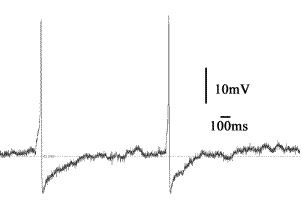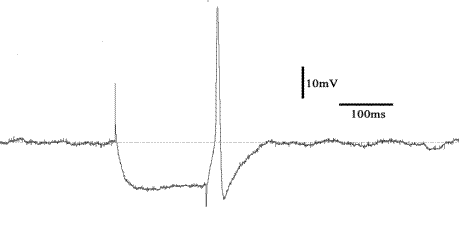| pA2 online © Copyright 2004 The British Pharmacological Society |
024P
University of Buckingham 3th Focused Meeting April 2004 |
|
Electrophysiological
and morphological characteristics of orexin a containing hypothalamic
neurones |
|
Neurones containing
orexin A are clustered in a region classically associated with feeding
regulation. Many of the neurones in this region are thought to contribute
to feeding regulation by monitoring plasma glucose levels (Song et al.,
2001; Eggerman et al., 2003). Here we have investigated the glucose sensitivity
of orexin containing neurones.
Wistar rats, either sex, 15-30 days old were deeply anaesthetised (ketamine
HCl, 60mg/kg), decapitated and hypothalamic slices prepared. Intracellular
recordings were made from 62 neurones in the perifornical region and the
responses of most of these neurones to 0.1, 2.5 and 5mM glucose and an
application of orexin A (1µM) were tested. The neurones were then
filled with neurobiotin for subsequent double immunofluorescent staining
to identify those neurones that expressed orexin.
Seven neurones were found to contain orexin A. Their resting membrane
potential ranged from -35 to -55 mV (Mean±SD = -44.29±9.72)
(Fig.1). All but one showed a rebound spike following hyperpolarising
pulses (Fig.2). Four of the five neurones tested were hyperpolarised (-3.40±4.4mV)
by increased glucose, or depolarised by lowering glucose (5.03±2.48).
Bath application of orexin A peptide (1µM) produced hyperpolarization
and reduction of spontaneous firing in two of four neurones tested.
Fig.1. Spontaneous activity of orexin cell.

Fig.2. After-hyperpolarisation rebound spike

Orexin A containing
neurones were multipolar with long thin beaded dendrites with few branches.
Axons of four neurones projected ventrally towards the arcuate nucleus,
two projected ventrolaterally towards the optic tract and one projected
dorsally reaching zona incerta area, suggesting that different groups
of orexin neurones project to different targets. Some received synaptic
contacts from orexin A containing boutons, suggesting that they express
autoreceptors that could account for their hyperpolarisation by orexin
A.
Eggerman et al. (2003). J Neurosci. 23, 1557-1562.
Song et al. (2001). Diabetes. 50, 2673-2674.
Funded
by the EU